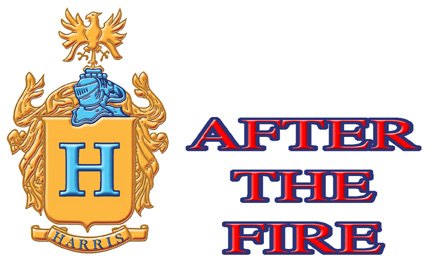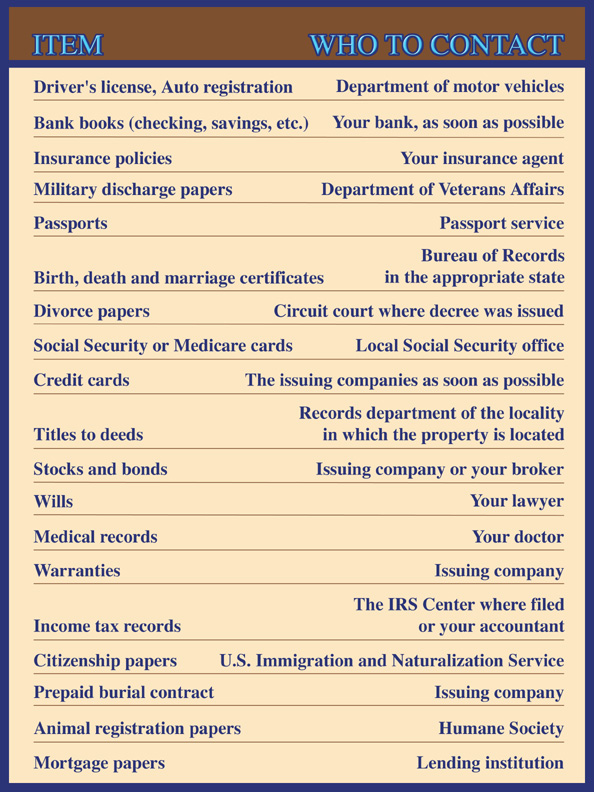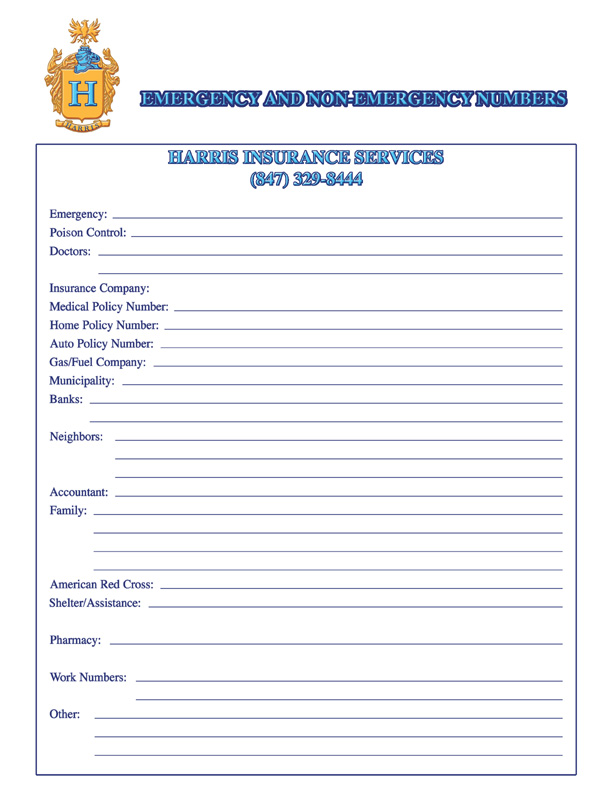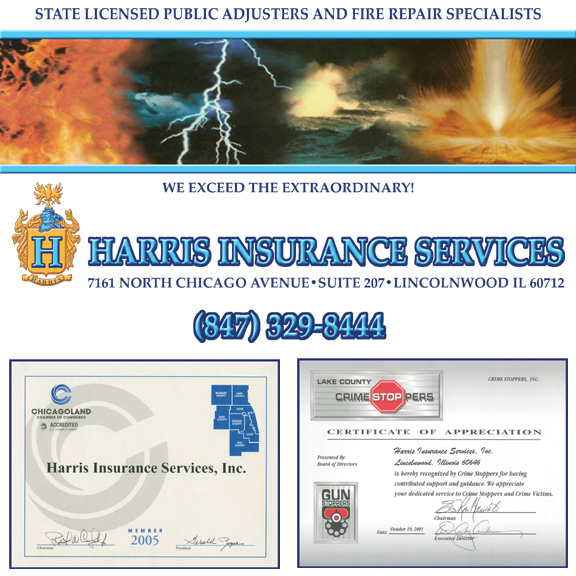

RETURNING TO NORMAL
Recovering from a fire can be a physically and mentally draining process.
When fire strikes, lives are suddenly turned around. Often, the hardest part is knowing where to begin and who to contact.
The Federal Emergency Management Agency's (FEMA)
United States Fire Administration (USFA) has gathered the following information to assist you in this time of need. Action on some of the suggestions will need to be taken immediately. Some actions may be needed in the future while others will be on going. The purpose of this information is to give you the assistance needed to assist you as you begin rebuilding your life.
THE FIRST 24 HOURS
Securing yourself and the site.
Contact your local disaster relief service, such as the American Red Cross or the Salvation Army, to help with your immediate needs, such as:
temporary housing
food
medicine
eyeglasses
clothing
other essential items
Contact your insurance agent/company.
Cautions
Do not enter the damaged site. Fires can rekindle from hidden, smoldering remains.
Normally, the fire department will see that utilities (water, electricity and natural gas) are either safe to use or are disconnected before they leave the site. Do not attempt to turn on utilities yourself.
Be watchful for structural damage caused by the fire. Roofs and floors may be damaged and subject to collapse.
Food, beverages and medicine exposed to heat, smoke, soot and water should not be consumed.
Leaving your home
Contact your local police departments to let them know that the site will be unoccupied.
In some cases it might be necessary to board up openings to discourage trespassers.
Beginning immediately, save receipts for any money you spend. These receipts are important in showing the insurance company what money you have spent related to your fire loss and also for verifying losses claimed on your income tax.
If it is safe to do so, try to locate the following items:
identification, such as driver's licenses and social security cards
insurance information
medication information
eyeglasses, hearing aids or other prosthetic devices
valuables, such as credit cards, bank books, cash and jewelry
There are many people/entities that should be notified of your relocation, including:
your insurance agent/company
your mortgage company (also inform them of the fire)
your family and friends
your employer
your child's school
your post office
any delivery services
your fire and police departments
your utility companies
Do not throw away any damaged goods until after an inventory is made. All damages are taken into consideration in developing your insurance claim.
If you are considering contracting for inventory or repair services discuss your plans with your insurance agent/company first.
IF YOU ARE INSURED
Give notice of the loss to the insurance company or the insurer's agent/company
Ask the insurance company what to do about the immediate needs of the dwelling, such as covering doors, windows, and other exposed areas, and pumping out water.
Ask your insurance agent/company what actions are required of you. Some policyholders may be required to make an inventory of damaged personal property showing in detail the quantity. description and how much you paid for the items.
IF YOU ARE NOT INSURED
Your recovery from a fire loss may be based upon your own resources and help from your community.
Private organizations that may be sources of aid or information:
American Red Cross
Salvation Army
religious organizations
department of social services
civic organizations
state or municipal emergency services office
non-profit crisis counseling centers
VALUING YOUR PROPERTY
You will encounter different viewpoints on the value of your property in adjusting your fire loss or in claiming a casualty loss on your federal income tax. Knowing the following terms will help you understand the process used to determine the value of your fire loss.
Your personal valuation: Your personal loss of goods through fire may be difficult to measure. These personal items have SENTIMENTAL VALUE to you; however, it is objective measures of value that you, the insurer, and the internal revenue service will use as a common ground for discussion. Some of these objective measures are discussed below.
Cost when purchased: This is an important element in establishing an item's final value. Receipts will help verify the cost price.
Fair market value after the fire: This concept is also expressed as ACTUAL CASH VALUE. This is what you could have received for the item if you had sold it the day before the fire. The price would reflect its cost at purchase minus the wear and tear it had sustained since purchase. DEPRECIATION is the formal term used to express the amount of value an item loses over a period of time.
Value after the fire: This is sometimes called the item's salvage value.
Restoration Services
There are companies that specialize in the restoration of fire damaged structures. Whether you or your insurer employs this kind of service, be clear of who will pay. Be sure to request an estimate of cost for the work. Before any company is hired check their references. These companies provide a range of services that may include some or all of the following:
securing the site against further damage
estimating structural damage
repairing structural damage
estimating the cost to repair or renew items of personal property
packing, transportation, and storage of household items
securing appropriate cleaning or repair subcontractors
storing repaired items until needed
REPLACEMENT OF VALUABLE DOCUMENTS AND RECORDS
Here's a check list of documents you will need to replace if they have been destroyed, and who to contact for information on the replacement process.

SALVAGE HINTS
Professional fire and water damage restoration businesses may be the best source of cleaning and restoring your personal belongings. Companies offering this service can be located in the phone directory.
Clothing
A word of caution before you begin: test garments before using any treatment, and follow the manufacturer's instructions. Several of the cleaning mixtures described in this section contain the substance Tri-Sodium Phosphate. This substance can be purchased under the generic name TSP. Tri-Sodium Phosphate is a caustic substance used commonly as a cleaning agent. It should be used with care and stored out of reach of children and pets. Wear rubber gloves when using if you have sensitive skin. Read the label for further information.
Smoke odor and soot can sometimes be washed from clothing. The following formula may work for clothing that can be bleached:
4 to 6 tbsp. Tri-Sodium Phosphate
1 cup household cleaner or chlorine bleach
1 gallon warm water
Mix well, add clothes, rinse with clear water. Dry thoroughly.
An effective way to remove mildew from clothing is to wash the fresh stain with soap and warm water, rinse, and then dry in the sun. If the stain has not disappeared, use lemon juice and salt or a diluted solution of household chlorine bleach.
Cooking Utensils
Your pots, pans, flatware, etc., should be washed with soapy water, rinsed and then polished with a fine-powdered cleaner. You can polish copper and brass with special polish, salt sprinkled on a piece of lemon, or salt sprinkled on a cloth saturated with vinegar.
Electrical Appliances
Don't use appliances that have been exposed to water or steam until you have a service representative check them. This is especially true of electrical appliances. In addition, steam can remove the lubricant from some moving parts.
If the fire department turned off your gas or power during the fire, call the electric or gas company to restore these services-do not try to do it yourself.
Food
Wash your canned goods in detergent and water. Do the same for food in jars. If labels come off, be sure you mark the contents on the can or jar with a grease pencil. Do not use canned goods when the cans have bulged or rusted. Do not refreeze frozen food that has thawed.
To remove odor from your refrigerator or freezer, wash the inside with a solution of baking soda and water, or use one cup of vinegar or household ammonia to one gallon of water. Baking soda in an open container or a piece of charcoal can also be placed in the refrigerator or freezer to absorb odor.
Rugs and Carpets
Rugs and carpets should be allowed to dry thoroughly. Throw rugs can be cleaned by beating, sweeping, or vacuuming, and then shampooing. Rugs should be dried as quickly as possible - lay them flat and expose them to a circulation of warm, dry air. A fan turned on the rugs will speed drying. Make sure the rugs are thoroughly dry. Even though the surface seems dry, moisture remaining at the base of the tufts can quickly cause the rug to rot. For information on cleaning and preserving carpets, call your carpet dealer or installer or a qualified carpet cleaning professional.
Leather and Books
Wipe leather goods with a damp cloth, then a dry cloth. Stuff purses and shoes with newspaper to retain shape. Leave suitcases open. Leather goods should be dried away from heat and sun. When leather goods are dry, clean with saddle soap. Rinse leather and suede jackets in cold water and dry away from heat and sun.
Wet books must be taken care of as soon as possible. The best method to save wet books is to freeze them in a vacuum freezer. This special freezer will remove the moisture without damaging the pages.
If there will be a delay in locating such a freezer, then place them in a normal freezer until a vacuum freezer can be found.
A local librarian can be a good source.
Locks and Hinges
Locks (especially iron locks) should be taken apart and wiped with oil. If locks cannot be removed, squirt machine oil through a bolt opening or keyhole, and work the knob to distribute the oil. Hinges should also be thoroughly cleaned and oiled.
Walls, Floors and Furniture
To remove soot and smoke from walls, furniture and floors, use a mild soap or detergent or mix together the following solution:
4 to 6 tbsp. Tri-Sodium Phosphate
1 cup household cleaner or chlorine bleach
1 gallon warm water
Wear rubber gloves when cleaning with this solution. Be sure to rinse your walls and furniture with clear warm water and dry thoroughly after washing them with this solution.
Wash a small area at one time, working from the floor up. Then rinse the wall with clear water immediately. Ceilings should be washed last.
Do not repaint until walls and ceilings are completely dry.
Your wallpaper can also be repaired. Use a commercial paste to repaste a loose edge or section. Contact your wallpaper dealer or installer for information on wallpaper cleaners. washable wallpaper can be cleansed like any other wall, but care must be taken not to soak the paper. Work from bottom to top to prevent streaking.
Wood Furniture
Do not dry your furniture in the sun. The wood will warp and twist out of shape.
Clear off mud and dirt.
Remove drawers. Let them dry thoroughly so there will be no sticking when you replace them.
Scrub wood furniture or fixtures with a stiff brush and a cleaning solution.
Wet wood can decay and mold, so dry thoroughly. Open doors and windows for good ventilation. Turn on your furnace or air conditioner if necessary.
If mold forms, wipe the wood with a cloth soaked in a mixture of borax dissolved in hot water.
To remove white spots or film, rub the wood surface with a cloth soaked in a solution of 1/2 cup household ammonia and 1/2 cup water. Then wipe the surface dry and polish with wax or rub the surface with a cloth soaked in a solution of 1/2 cup turpentine and 1/2 cup linseed oil. Be careful - turpentine is combustible.
You can also rub the wood surface with a fine grade steel wool pad dripped in liquid polishing wax, clean the area with a soft cloth and then buff.
Money Replacement
Handle burned money as little as possible. Attempt to encase each bill or portion of a bill in plastic wrap for preservation. If money is only half burned or less (if half or more is still intact), you can take the remainder to your regional Federal Reserve bank for replacement. Ask your bank for the nearest one. Or you can mail the burned or torn money by "registered mail, return receipt requested" to:
Department of the Treasury
Bureau of Engraving and Printing
Office of Currency Standards
P.O. Box 37048
Washington DC 20013
Mutilated or melted coins can be taken to your regional Federal Reserve bank or mailed by "registered mail, return receipt requested" to:
Superintendent
U.S. Mint
P.O. Box 400
Philadelphia PA 19105
If your U.S. Savings Bonds have been destroyed or mutilated, you must obtain Department of Treasury Form PD F 1048 (I) from your bank or www.ustreas.gov and mail to:
Department of the Treasury
Bureau of Public Debt
Savings Bonds Operations
P.O. Box 1328
Parkersburg WV 26106-1328
Tax Information
Check with an accountant, tax consultant or the Internal Revenue Service (IRS) about special benefits for people with limited financial needs after a fire loss.
A WORD ABOUT FIRE DEPARTMENT OPERATIONS
Common Questions
Q. Why are windows broken or holes cut into the roof?
As a fire burns, it moves upward then outward. Breaking the windows and/or cutting holes in the roof (called ventilation) slows the damaging outward movement, helps remove blinding smoke that obscures the actual fire, and enables firefighters to fight the fire more efficiently. The result of this action is less damage to the structure in the long run.
Q. Why are holes cut in walls?
This is done so that the fire department is absolutely sure that the fire is completely out, and that there is no fire inside the walls or other hidden places.
Q. Is it possible to obtain a copy of the fire report?
In most localities, a fire report is a public document and is available at the fire department or fire marshal's office.
EMERGENCY AND NON-EMERGENCY NUMBERS
Right-click and print the following page and fill it in with your local phone numbers and keep copies at locations other than your home:

THE FOLLOWING CHECKLIST SERVES AS A QUICK REFERENCE AND GUIDE FOR YOU TO FOLLOW AFTER A FIRE STRIKES:
1. Contact your local disaster relief service, such as the Red Cross, if you need temporary housing, food and medicines.
2. If you are insured, contact your insurance company for detailed instructions on protecting the property, conducting inventory and contacting fire damage restoration companies. If you are not insured, try contacting private organizations for aid and assistance.
3. Check with the fire department to make sure your residence is safe to enter. Be watchful of any structural damage caused by the fire.
4. The fire department should see that utilities are either safe to use or are disconnected before they leave the site. Do NOT attempt to reconnect utilities yourself.
5. Conduct an inventory of damaged property and items. Do not throw away any damaged goods until after an inventory is made.
6. Try to locate valuable documents and records. Refer to information on contacts and the replacement process described above.
7. If you leave your home, contact the local police department to let them know the site will be unoccupied.
8. Begin saving receipts for any money you spend related to fire loss. The receipts may be needed later by the insurance company and for verifying losses claimed on income tax.
9. Notify your mortgage company of the fire.
10. Check with an accountant or the Internal Revenue Service about special benefits for people recovering from fire loss.

Our Professional Staff | Our 2–Phase System | Q and A | Restoration | Our Clients | Service Area | Contact Us
Emergency | After the Fire | Client Survey | Fire Facts | Links | Our Guarantee | Home | Site Map | BBB